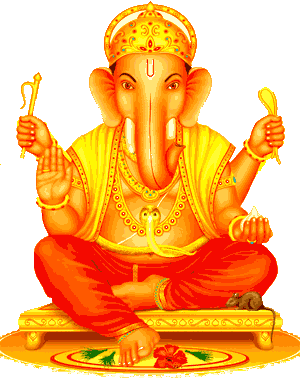Shree Ganesha…
Ganapati bappa Morya. !!!!!!!
Ohm Vighneswaraya Namah ! Vinayakaya Namah ! Ganapathaye Namah !
Gajamughaya Namah ! Parvati nandanaya Namah ! Mushika vahanaya Namah ! Kailasa Putraya Namah !
 |  |  |
Lord Ganesha
Lord Ganesha symbolizes
the ideals of perfection
as conceived by Hindu sages
and illustrates concepts of
profound spiritual significance.
Elephant head, wide mouth, and large ears

The large head of an elephant
symbolizes wisdom, understanding,
and a discriminating intellect
that one must possess to attain perfection in life.
The wide mouth represents the
natural human desire to enjoy life in the world.
The large ears signify that a perfect person
is the one who possesses a great capacity
to listen to others and assimilate ideas.
The trunk and two tusks
The trunk and two tusks
with the left tusk broken 

Just as an elephant”s trunk
can uproot a tree and yet lift a needle
from the ground.
the human mind must be strong enough to face
the ups and downs of the external world
and yet delicate enough to explore the subtle
realms of the inner world.
The two tusks denote the two aspects
of the human personality, wisdom and emotion.
The right tusk represents wisdom and the
left tusk represents emotion.
The broken left tusk conveys the idea
that one must conquer emotions with
wisdom to attain perfection.
Elephant eyes
Elephant eyes

The elephant eyes are said to possess
a natural deceptiveness that allow them
to perceive objects to be bigger than
what they really are.
Thus the elephant eyes symbolize the idea
that even if an individual gets
“bigger and bigger”
in wealth and wisdom, he should perceive others
to be bigger than himself; that is,
surrender one”s pride and attain humility.
The four arms and various
The four arms and various
objects in the four hands

The four arms indicate that the Lord
is omnipresent and omnipotent.
The left side of the body symbolizes emotion
and the right side symbolizes reason.
An axe in the upper left hand and a lotus in
the upper right hand signify that in order
to attain spiritual perfection,
one should cut worldly attachments and
conquer emotions.
This enables one to live in the world without
being affected by earthly temptations,
just as a lotus remains in water but is not affected
by it. A tray of Laddus (a popular snack) near
the Lord denotes that He bestows wealth and prosperity upon His devotees.
The lower right hand is shown in a blessing
pose, which signifies that Ganesha always
blesses His devotees.
A human body with a big belly
The human body possesses a human heart,
which is a symbol of kindness and compassion
towards all.
Ganesha”s body is usually portrayed wearing
red and yellow clothes.
Yellow symbolizes purity,
peace and truthfulness.
Red symbolizes activity in the world.
These are the qualities of a perfect person who
perforrns all duties in the world,
with purity, peace, and truthfulness.
The big belly signifies that a perfect individual
must have a large capacity to face
all pleasant and unpleasant experiences of the world.
A mouse sitting near the feet
A mouse sitting near the feet
of Ganesha and gazing
at the tray of Laddus:

A mouse symbolizes the ego that can nibble all that
is good and noble in a person.
A mouse sitting near the feet of Ganesha
indicates that a perfect person is one
who has conquered his (or her) ego.
A mouse gazing at the Laddus, but not consuming them,
denotes that a purified or controlled ego can live in the
world without being affected by the worldly temptations.
The mouse is also the vehicle of Ganesha,
signifying that one must control ego
in order for wisdom to shine forth.
Right foot dangling
over the left foot 

The left side of the body symbolizes emotion and
the right side symbolizes reason and knowledge.
The right foot dangling over the left foot illustrates that
in order to live a successful life one should utilize
knowledge and reason to overcome emotions.
No comments:
Post a Comment